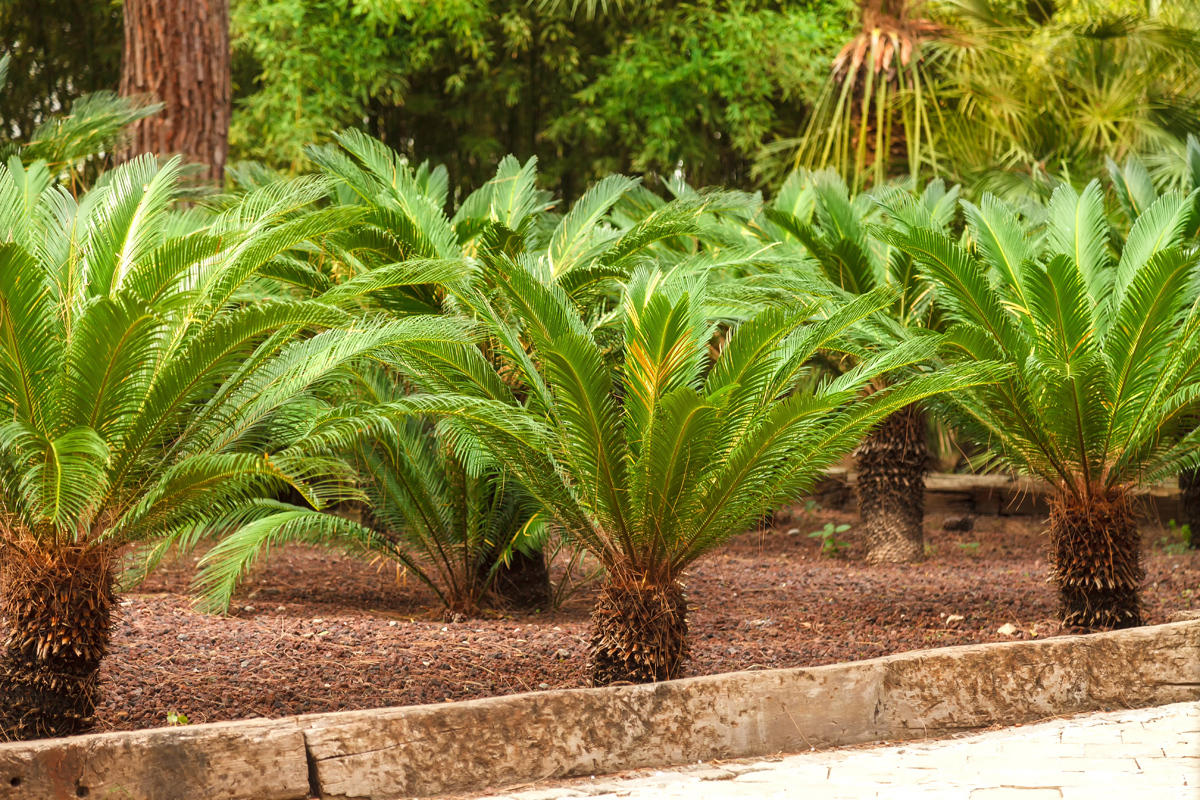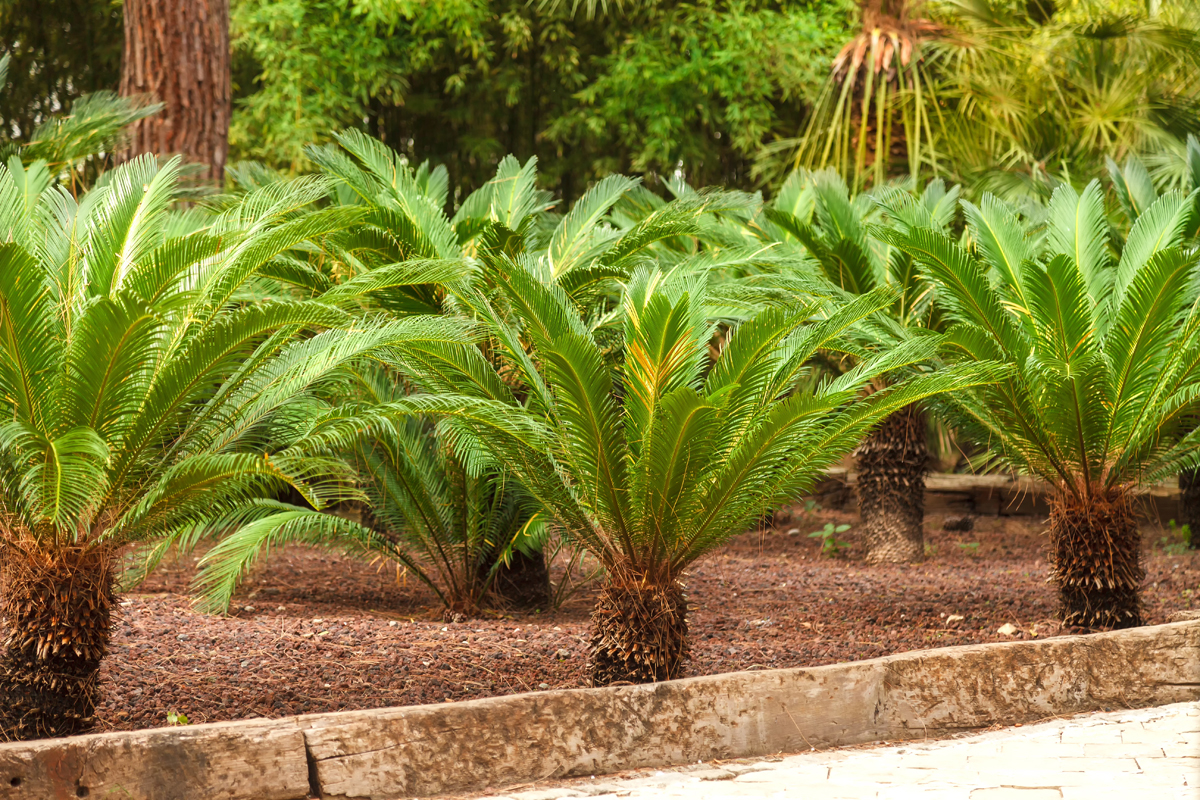
What are some common sago palm issues and how can you trim this tree to save or prolong its life? Follow our guide below.
Sago Palm Tree Care
Sago palms (Cycas revoluta) have large fronds comparable to most other palm species, but they are cycads and more closely related to conifer trees. Sago palms grow in USDA plant hardiness zones 8-10, with mature trees sometimes reaching as much as 10-feet tall.
Oftentimes, yellow fronds can result from a nutrient deficiency. This can be remedied with a boost of fertilizer, including a citrus fertilizer. Sickly-appearing plants are sometimes brought back to health with manganese sulfate watered into the soil.
One common issue with sago palms is Manganese deficiency. Try to fertilize your palms every six weeks during growing season. Some homeowners may choose to prune the plant by simply removing yellow leaves, but this is not recommended by the tree professionals. This may ultimately cause the problem to worsen over time, gradually moving up to the next tier of leaves.
As the leaves begin to die, they can still absorb nutrients. If they are removed at this time, this could stunt plant growth overall, leaving the tree susceptible to infections. The experts recommend only pruning leaves that are brown aka dead.
Common Sago Palm Issues
Your sago palm turning yellow is mainly the result of a mixture of location, nutrition and amount of light. Sago palms can thrive on both the east and west coast. Let’s look at some of the common sago palm issues below, and what you can do to properly care for these trees.
1. Amount Of Light
Sago palms will thrive under really bright, indirect sunlight. It’s recommended to set their container somewhere that receives full sun but partial shade. This type of lighting can help yellowing leaves to eventually become greener over time.
If you are having trouble getting the perfect amount of light to your palm, it is okay to try other methods. In some cases, adding artificial LED lighting turned on 24/7 can help keep the leaves green.
2. Overwatering
Properly watering any plant can be difficult to figure out, with sago palms being no different. Incorrect watering is one of the leading causes of yellowing in sago palms.
Though some homeowners choose to keep their sago palm indoors, they do better overall when they are outside. Always ensure your sago palms have good drainage and refrain from leaving them in standing water. This can result in yellowing leaves.
3. Nutrition
Knowing your soil type and acidity levels will give you the best chance possible to grow a healthy sago palm. Magnesium deficiency causes color changes in these leaves, so it’s best to use a slow-release fertilizer. Be sure not to overdo it with the fertilizer, though, as an excess of fertilizer can cause leaves to yellow.
4. Cold Spells
These palms always do best in warm climates, but they are not immune to cold spells. This happens as the roots seize up, which makes it tougher for the palms to absorb the necessary nutrition.
The remedy is to simply not panic and continue to maintain good care of your palm. The leaves should become green again over time.
5. Acclimation Time
Like most things, sago palms are not fond of being disturbed. This means if you have recently moved or repotted the palm, it may take some to acclimate to the new surroundings. Yellow foliage and some droppings may be noticed at this time.
However, once the roots re-establish, the green color should be restored. Ensure your lighting levels are ideal and avoid any other disturbances to the plant. It’s wise to always acclimate your plants to new environments slowly.
How To Trim A Sago Palm Tree
Pruning these trees is only a necessity for aesthetics. You can remove the cone from the Sago’s center carefully, being sure not to damage the growing point below. If this is left in place, the cone can break apart and fall off on its own once the new foliage takes over. If the old foliage becomes tattered, cut them off as close to the trunk as possible after new leaves have unfolded entirely.
Keep from ever excessively pruning the leaves, removing only dead or damaged leaves. Cutting away any green fronds may weaken the plant’s health overall. This will make it more susceptible to both pests and diseases.
Start this process by cutting the oldest and lowest leaves close to the trunk. In some cases, all but the very top fronds need to be removed, although this can be extreme. Refrain from trimming any sago leaves that are located between ten and two o’clock.

Tree Removal Services In Arizona
Hayward Tree is offering tree removal from above using a specialized crane. The benefit of this service is that we can remove your tree from above and avoid tearing up your yard and leaving drag marks. No broken limbs, no crushed bushes. It’s quick, efficient, and leaves your property looking clean, undisturbed, and untouched. Best of all, it’s at no additional cost to you! Contact our team today for a free estimate!




